The Checker Maven
The World's Most Widely Read Checkers and Draughts Publication
Bob Newell, Editor-in-Chief
Published each Saturday morning in Honolulu, Hawai`i
Contests in Progress:
The New Year Rushes In

Click on a problem to display it; when you're done, click on Read More to check your solutions.
But above all, enjoy the New Year and keep on reading the weekly editions of The Checker Maven!
New Year's Eve Speedster No. 1
New Year's Eve Speedster No. 2
![]()
A Holiday Puzzler

Whatever holidays you celebrate, The Checker Maven wishes you the best of the season and hopes you enjoy this special challenger, our holiday gift to you.
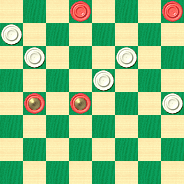
White
White to Play and Draw
W:W5,9,11,15,20:B2,4,K17,K18.
White may be a man up, but Black has two kings and a strong position. Can you provide some holiday cheer for the White side?
In the spirit of giving, here's a hint: the natural-looking 5-1 loses. Can you tell why?
Click on Read More to unwrap the solution.![]()
Pretty Complex, But ....

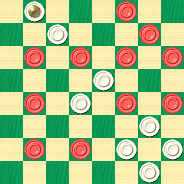
WHITE
White to Play and Win
Can you make waves with your solution, or will quantum indeterminacy hide the answer? After you've tried out the problem, click on Read More to find out.![]()
Can You Escape From The Growling Bear?
About a year ago, we presented a very difficult setting composed by Brian Hinkle, and just a few top players were able to solve it. This month, Brian has favored us with another of his offerings. It's of a very different nature than last year's, but it's a real teaser, and Brian has composed a little story to go along with it.

The amazing position shown below arose in the 40th and final game of the Go Where You Want World Title Match, played in the year 2012 at the San Francisco Checker Palace.
The match was tied 4-4 with 31 draws and the defending World Champion, Run Fora King (Black) only needed a draw to retain his title against his arch-rival Al X. Noisyev (White), better known as the "Growling Bear of Checkers" for his antics both on and off the checker board.
Early in this game, King played a gambit line in the Old 14th and The Bear responded by immediately giving back the man to obtain the best theoretical position--- at least in his view.
As the midgame progressed, the Bear offered Run a useless king in the single corner on square 29, which he accepted, being true to his name. In the late midgame, the Bear pitched a man in order to crown five White kings --- his patented "bear claw" tactic --- and place them on key squares, thus securing maximum pressure on the exposed Black pieces in the middle of the board.
Under extreme pressure and with the world title at stake, Run Fora King escaped with a draw in this difficult position, leaving the Growling Bear still hungry for the coveted and elusive GWYW World Title.
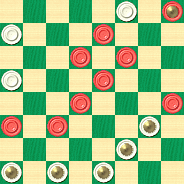
BLACK
Black to Play and Draw
B:W30,28,20,K9,K6,K4,K3,K2:BK29,26,23,22,18,15,13,12,11.
Were you able to sight solve this or did you have to move the pieces around? How long did it take you to solve it by either method?
Please send your proposed solutions and solving times to Brian Hinkle at sbhinkle@charter.net. Brian's solution and commentary will be published in the columns of The Checker Maven in the first part of 2006.
Starting with this article, we're adding FEN notation to our diagrams, at the request of our readers. If you are not familiar with FEN and PDN, a good description can be found on Wikipedia.![]()
Jackpot

Here at The Checker Maven, we've long felt that we've "hit the jackpot" with our more than 2,500 weekly readers and the acceptance and welcome our webzine has received in its first year of publication. To celebrate, we've turned to who else but Tom Wiswell, for a nice problem which he himself has entitled Jackpot. It's not too hard (at least by Wiswell standards) but has a neat finish that you can't help but admire. The problem is co-authored by Jack Botte and looks like this:
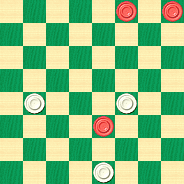
WHITE
White to Play and Win
When you've pulled the lever on your solution, click on Read More to see what Tom had to say.
[Read More]Total Insanity

This month we bring you what is possibly the most insane stroke problem ever conceived. It's a completely artificial situation and has no practical play value, but as a test of visualization it is unrivaled.

WHITE
White to Play and Win
Try this problem without (1) using your computer, and (2) getting out an extra checker set so you can move the men around on your board. In other words, be crazy and sight-solve it!
When you have the answer, or have completely gone off your rocker, click on Read More for the solution.![]()
Two Final Not-So-Easy Pieces
Today, we reach the end of the "introductory" tactical problems and examples in our ongoing electronic republication of Willie Ryan's celebrated Tricks Traps & Shots of the Checkerboard. The problems have been getting harder and harder... and we haven't even gotten to the main parts of the book! Here's Willie once more:
BLACK
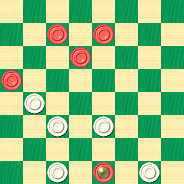
WHITE
White to Play and Win
"Many a losing position has been won or drawn, in the last minute of play, by a brilliant series of startling moves. Example 17 pictures white in what appears to be a hopeless predicament; yet white can turn the tables to win by a neat 'backup and throwback' stratagem this is as pleasing as it is deceptive. The backup idea is employed to get tactical support or 'backing' from an opponent's piece--- to use that piece as one of your own men. All compound shots are essentially based on the backup principle. A throwback or 'pitch-out' is a clever method of ousting an opponent's king from your king row (by sacrificing one or more pieces) in order to capture it on the bound.
BLACK
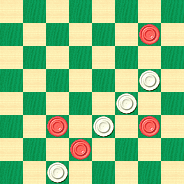
WHITE
White to Play and Win
For our closing study, Example 18, we feature an advanced player's problem that brings into play some of the tactical ideas we have discussed in the preceding examples. Instead of expecting our beginners to solve this chestnut, we will briefly review the solution and denote the play, step by step."
Whoa, just a minute there, Willie! Let's let our readers try it on their own first! After all, they can always click on Read More to see the solutions!![]()
Checker School: Coming From Behind, Part 2

Today we present the second in our series of three lessons on classic "man down draw" positions. No one who has played more than a few games has failed to encounter some of these seemingly lost situations, and, most likely, missed out on a possible draw.
The position below is attributed to Dr. T. J. Brown, and found in Ben Boland's classic, Famous Positions in the Game of Checkers:
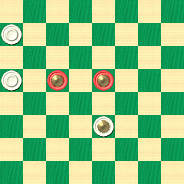
BLACK
Black to Play and Draw
We immediately note a similarity to last month's lesson: a single Black king is holding two White men at bay on the edge of the board. Once again, there is hope, and with careful play, Black can save the draw. (And we do mean careful play; a typical learner's attempt, 18-15, loses at once to 28-24.)
Work this one out for yourself, and then click on Read More for a detailed solution.![]()
Time Flies

November Speed Problem (medium difficulty)
[Read More]Black to Move and Crown

Here's one that's a little different, and although out of the mainstream of checker problems, we think you'll find it an interesting exercise in visualization. Here's the situation:
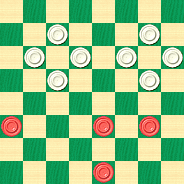
BLACK
Black to Move and Crown
For this puzzle, in which play adheres to the normal rules of checkers, Black is to crown a man while White is to prevent the attempt. Can you guide a Black man to the ranks of royalty? When you're done, click on Read More to see if your solution is truly noble.![]()
The Checker Maven is produced at editorial offices in Honolulu, Hawai`i, as a completely non-commercial public service from which no profit is obtained or sought. Original material is Copyright © 2004-2025 Avi Gobbler Publishing. Other material is the property of the respective owners. Information presented on this site is offered as-is, at no cost, and bears no express or implied warranty as to accuracy or usability. You agree that you use such information entirely at your own risk. No liabilities of any kind under any legal theory whatsoever are accepted. The Checker Maven is dedicated to the memory of Mr. Bob Newell, Sr.

